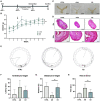Mitigating Effect of Estrogen in Alzheimer's Disease-Mimicking Cerebral Organoid
- PMID: 35401074
- PMCID: PMC8990972
- DOI: 10.3389/fnins.2022.816174
Mitigating Effect of Estrogen in Alzheimer's Disease-Mimicking Cerebral Organoid
Abstract
Alzheimer's disease (AD) is the most common condition in patients with dementia and affects a large population worldwide. The incidence of AD is expected to increase in future owing to the rapid expansion of the aged population globally. Researchers have shown that women are twice more likely to be affected by AD than men. This phenomenon has been attributed to the postmenopausal state, during which the level of estrogen declines significantly. Estrogen is known to alleviate neurotoxicity in the brain and protect neurons. While the effects of estrogen have been investigated in AD models, to our knowledge, they have not been investigated in a stem cell-based three-dimensional in vitro system. Here, we designed a new model for AD using induced pluripotent stem cells (iPSCs) in a three-dimensional, in vitro culture system. We used 5xFAD mice to confirm the potential of estrogen in alleviating the effects of AD pathogenesis. Next, we confirmed a similar trend in an AD model developed using iPSC-derived cerebral organoids, in which the key characteristics of AD were recapitulated. The findings emphasized the potential of estrogen as a treatment agent for AD and also showed the suitability of AD-recapitulating cerebral organoids as a reliable platform for disease modeling and drug screening.
Keywords: Alzheimer’s disease; amyloid-beta; cerebral organoid; estrogen; induced pluripotent stem cells.
Copyright © 2022 Kim, Mo, Kim, Kim, Nam, Rim and Ju.
Conflict of interest statement
JK and YN are employed by YiPSCELL, Inc. JHJ is founder of YiPSCELL, Inc. The remaining authors declare that the research was conducted in the absence of any commercial or financial relationships that could be construed as a potential conflict of interest.
Figures




Similar articles
-
Mouse induced pluripotent stem cells-derived Alzheimer's disease cerebral organoid culture and neural differentiation disorders.Neurosci Lett. 2019 Oct 15;711:134433. doi: 10.1016/j.neulet.2019.134433. Epub 2019 Aug 14. Neurosci Lett. 2019. PMID: 31421155
-
Generation of Alzheimer's Disease Model Derived from Induced Pluripotent Stem Cells with APP Gene Mutation.Biomedicines. 2024 May 27;12(6):1193. doi: 10.3390/biomedicines12061193. Biomedicines. 2024. PMID: 38927400 Free PMC article.
-
Enhanced Neuronal Activity and Asynchronous Calcium Transients Revealed in a 3D Organoid Model of Alzheimer's Disease.ACS Biomater Sci Eng. 2021 Jan 11;7(1):254-264. doi: 10.1021/acsbiomaterials.0c01583. Epub 2020 Dec 21. ACS Biomater Sci Eng. 2021. PMID: 33347288
-
Optimization of cerebral organoids: a more qualified model for Alzheimer's disease research.Transl Neurodegener. 2021 Aug 9;10(1):27. doi: 10.1186/s40035-021-00252-3. Transl Neurodegener. 2021. PMID: 34372927 Free PMC article. Review.
-
Modeling and Targeting Alzheimer's Disease With Organoids.Front Pharmacol. 2020 Mar 31;11:396. doi: 10.3389/fphar.2020.00396. eCollection 2020. Front Pharmacol. 2020. PMID: 32300301 Free PMC article. Review.
Cited by
-
Sex differences in Alzheimer's disease: an urgent research venue to follow.Neural Regen Res. 2024 Dec 1;19(12):2569-2570. doi: 10.4103/NRR.NRR-D-23-01971. Epub 2024 Mar 1. Neural Regen Res. 2024. PMID: 38808985 Free PMC article. No abstract available.
-
Stem Cell Therapy for Alzheimer's Disease: A Scoping Review for 2017-2022.Biomedicines. 2023 Jan 3;11(1):120. doi: 10.3390/biomedicines11010120. Biomedicines. 2023. PMID: 36672626 Free PMC article.
-
Morphogenetic Designs, and Disease Models in Central Nervous System Organoids.Int J Mol Sci. 2024 Jul 15;25(14):7750. doi: 10.3390/ijms25147750. Int J Mol Sci. 2024. PMID: 39062993 Free PMC article. Review.
-
Targeting the non-classical estrogen pathway in neurodegenerative diseases and brain injury disorders.Front Endocrinol (Lausanne). 2022 Sep 15;13:999236. doi: 10.3389/fendo.2022.999236. eCollection 2022. Front Endocrinol (Lausanne). 2022. PMID: 36187099 Free PMC article. Review.
-
Mind the Gap: Unraveling the Intricate Dance Between Alzheimer's Disease and Related Dementias and Bone Health.Curr Osteoporos Rep. 2024 Feb;22(1):165-176. doi: 10.1007/s11914-023-00847-x. Epub 2024 Jan 29. Curr Osteoporos Rep. 2024. PMID: 38285083 Free PMC article. Review.
References
-
- Alzamora R., Brown L. R., Harvey B. J. (2007). Direct binding and activation of protein kinase C isoforms by aldosterone and 17β-estradiol. Mole. Endocrinol. 21 2637–2650. - PubMed
LinkOut - more resources
Full Text Sources

